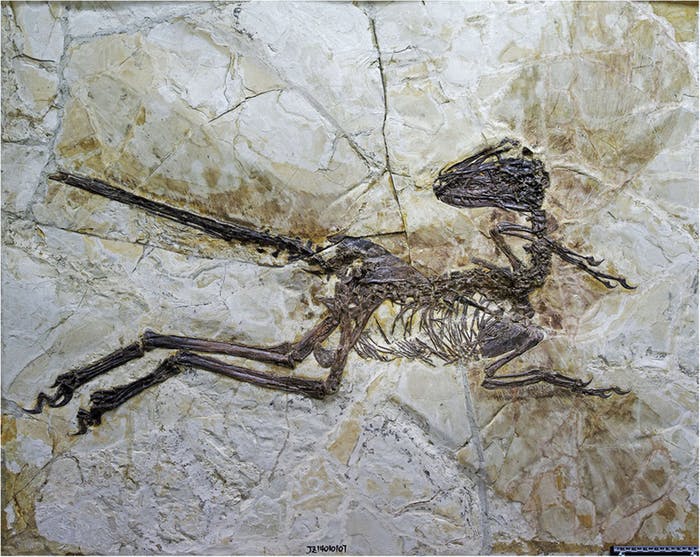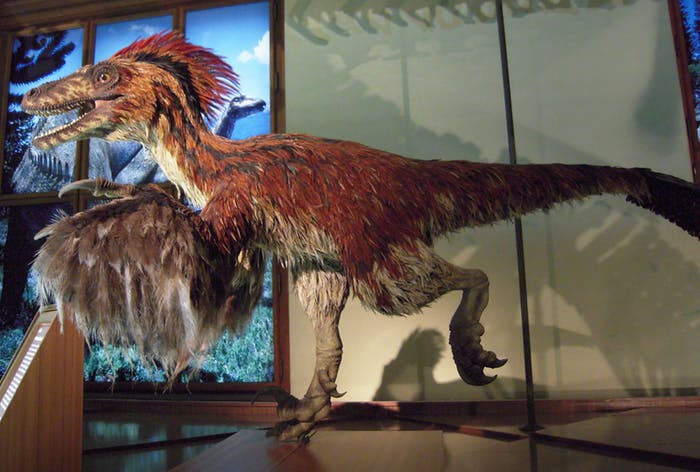Paleoartist Gives Toronto Raptors Logo a Strange Yet Accurate Redesign

The Toronto Raptors have only one thing in common with the velociraptors that reigned over Earth between 100.5 to 66 million years ago: Both of them were met with a swift demise at the hands of forces greater than their own. But just because the Cleveland Cavaliers swept Toronto much like a cataclysmic force decimated our prehistoric friends doesn’t mean the team’s semi-menacing dinosaur logo should be equated with the real thing.
Paleoartist and “Torontoish” dinosaur enthusiast, Hannah Moss, took to Twitter on Saturday to ensure all Toronto Raptors and Jurassic Park fans know what an actual velociraptor is supposed to look like: ferocious and feathery.
“There are two big inaccuracies that appear in the logo, and they’re really the two main mistakes you see in most drawings of dinosaurs,” Moss tells Inverse. “One, there aren’t any feathers. Two, the hands and wrists are facing the wrong direction. It is now widely accepted within the paleontology community that raptors had feathers on their arms and tails due to the presence of ‘quill knobs’ found in fossilized bones.”

In her redesign, Moss recreated Velociraptor mongoliensis, the quintessential raptor you see in all the Jurassic Park flicks. While Hollywood might depict our ancient friends as scaly, reptile-like creatures, paleontologists have long established that these dinos — the evolutionary predecessors of modern-day birds — most definitely had feathers.
A 2007 discovery published in the journal Science was the first time researchers found quill knobs in velociraptor fossils. Since then, there have been multiple discoveries of dinosaurs feathers completely encased in amber, so at least Jurassic Park got that right.
Sadly, there’s no evidence suggesting that velociraptors used their flashy feathers to fly, an ability that the team might have found useful in its battle with Lebron James. Air travel was left to pterodactyls; nevertheless, raptor plumage was for much more than just show.

“The quill knobs found on arm and tail bones, along with fossils bearing the imprints of actual feathers, hint at how these feathers were arranged,” says Moss. “As for their purpose, a coat of feathers all over the body likely served as insulation. Long wing feathers would help aid balance, as would long tail feathers, although it’s also not unlikely that raptors, like modern birds, used their feathers in mating or threat displays.”
Moss curates and showcases other Paleoartists’ work on her other Twitter account, Unique Paleoart. By sharing and drawing her own dinosaur recreations, she hopes to educate the public about what dinosaurs actually might have looked like, based on recent studies.

“Soft tissues and feathers often don’t fossilize, so it’s likely that dinosaurs were a lot chubbier and fluffier than most people think,” she says. “The general public might not be too eager to read through pages and pages of reports on the most recent dinosaur fossil discoveries, but paleoartists will and translate that knowledge into artwork, an instantly understandable medium.”
So, raptors might have actually had thicc bods like Barney the Dinosaur. Time to rework that chiseled logo, Toronto.
Source: www.inverse.com








